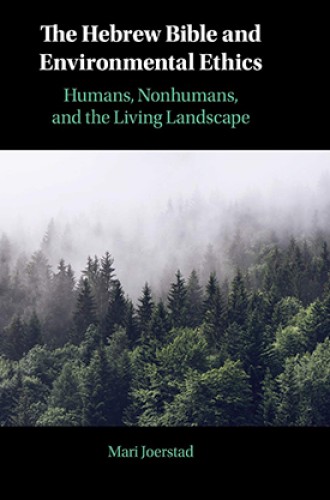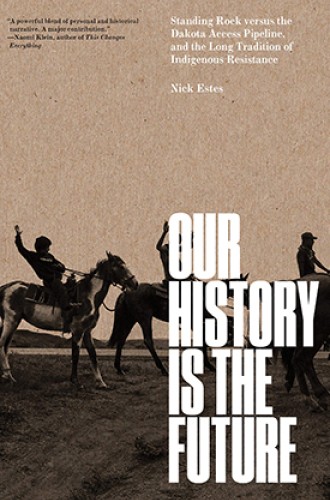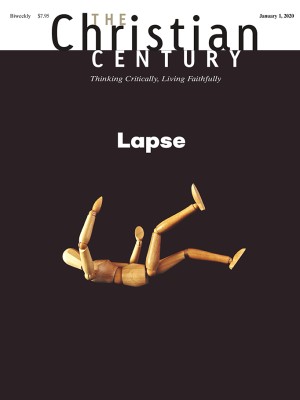What if we treated all of creation—plants and stars, soil and rivers—as our kin?
Biblical scholar Mari Joerstad and indigenous activist Nick Estes challenge our human-centered worldview.
Plants were invited to worship as the guests of honor at Union Theological Seminary in New York City this past September. During their chapel service, students confessed their sins against nature to the flora which occupied the center of the space—peace lilies and pothos vines, ornamental millet and a rattlesnake plant, basil and a palm tree, an assortment of common houseplants and landscaping plants, all of them resting in pots on a patch of soil. People were invited to offer words of repentance to the plants. “I confess that so many trees held me in their branches as I grew,” one student professed during the service, “but I have not held you in return.” Throughout the service, people referred to the plants as subjects worthy of address, with the personal intimacy of “you.”
Social media was immediately in a stir with what has become known as #plantgate. When Albert Mohler, president of the Southern Baptist Theological Seminary in Louisville, Kentucky, heard about the event, he responded with indignation. “A stalk of wheat is not a being, nor is a rhododendron, nor is an oak tree, nor even an acorn, nor is an entire forest,” Mohler vented on his podcast. “Plants are not beings, but what you see here is the confusion that happens when the biblical worldview is abandoned.”
Read our latest issue or browse back issues.
For someone who says he takes the Bible seriously, Mohler’s commentary on the worship service displays a profound ignorance of biblical worldviews about nature. He would benefit from Mari Joerstad’s new book, which is a revised version of her dissertation, written at Duke University under the guidance of Ellen Davis.
Joerstad’s careful reading of scripture reveals that the biblical world teems with beings, many of whom are nonhuman creatures with emotional lives, and nonhuman moral agents who are participants in God’s covenant. Throughout the scriptures, nonhuman animals and nonanimal elements of nature have personal relationships with God and human beings.
Joerstad organizes her exegesis according to the traditional Hebrew divisions of the Bible: the Torah, the Prophets, and the Writings. Her writing style invites readers to take notice of personalities that run through various texts while her descriptions fill in the features of nonhuman creatures as she introduces them: trees and stars, sea and soil, all of whom exhibit characteristics of personhood.
The land is a central character which engages in a personal relationship with God and human beings. As Joerstad points out, the ground itself takes personal offense at human transgressions. In Genesis 4, for example, the soil witnesses Cain’s murder of Abel. In response to this violence, Joerstad explains, “the ground does not passively soak up blood; it actively takes the blood of Cain’s hand.” As the Hebrew text reads, “the ground has opened its mouth to take your brother’s blood” (Gen. 4:11). The soil then curses Cain and promises never to produce food for him or let him rest: “a vagrant and a wanderer you will be in the earth” (Gen. 4:12). As the narrative develops, Joerstad notes, “the ground is now in control of Cain’s life.”
Later in the Bible, Job speaks directly to the earth, requesting that the land not treat him the way it (she? he? they?) treated Cain (Job 16:18). Job then calls upon the ground to bear witness to his innocence. “If my farmland has cried out against me, and its furrows have wept together,” Job declares, “may thorns come forth” (31:38–40). He knows that the soil adjudicates, that the land judges sins. He knows that the earth which presses between his toes, which assembles under his fingernails, which reaches into the pores of his skin, is a companion who knows his secrets, the intimacies of his life. “In both cases, the ground assesses human conduct and responds accordingly,” Joerstad observes, as it “reacts to human transgression.”
Job is in relationship with the land and with other creatures. Eliphaz calls this relationship a covenant with the stones of the field and a peace covenant with animals (Job 5:23). However, as Joerstad notes, translators shy away from using covenantal language here. Both the KJV and the NRSV translate the Hebrew word berith in this verse, usually translated as covenant, as “in league with.” Translation committees seem to be uncomfortable with inter-creaturely covenantal unions.
Leviticus invites humans into a posture of mutual recognition with the ground, since the two moral actors are bound up together in a relationship with the same God. Joerstad points out that Levitical ordinances guide farmers to see their resemblance in the earth: “Leviticus 19:9 says not to reap the corners of your field; 19:27 makes the same suggestion for the farmer’s hair: ‘do not trim the corner of your temples.’” One mirrors the other: “the farmer’s head is like the farmer’s field—you cannot look at one without thinking of the other.” Agricultural labor is a form of self-knowledge, a reminder of kinship between adam and adamah. As Joerstad puts it, “Leviticus 19 reminds me of a childhood delight in coming to school in an identical outfit as my best friend.”
Other personalities emerge in Joerstad’s book, like the trees who fight alongside David’s army. The description of arboreal warfare in 2 Samuel 18:8 (“the forest consumed more people than the sword”), she notes, “brings to mind Tolkien’s Ents and Huorns,” alluding to a scene from The Lord of the Rings. But “commentators have spent little time on this verse, despite the intriguing idea of tree soldiers.”
Joerstad also describes other biblical war scenes where nonhuman actors play decisive roles. The prophet Deborah, for instance, rejoices in gratitude to the stars and to a wadi which joined forces to defeat the Canaanite commander Sisera (Judg. 5:20–21). Trees, stars, and waters all participate in warfare when their beloved people, their companions, are under threat.
Joerstad also tracks the emotional life of nonhuman creatures, like a landscape’s joy at the return of exiled people, which causes mountains and hills to burst into jubilation and forests to applaud (Isa. 55:12). In the prophetic writings, Joerstad observes, “trees will clap their hands, not because humans are the most important creature, but because humans, animals, plants, and lands desire each other and depend on each other for well-being, flourishing, and joy.”
There is joy and there is also mourning: the grief of soils and trees, of plants and rivers. In a key reflection on her hermeneutics, Joerstad explains how she understands the biblical attribution of human grief to nonhuman creatures: “These texts do not betray a naïve anthropomorphism or an escape into rhetorical fancy, but a concerted effort to observe and respect the perspective of all persons, be they human, animal, or other-than-animal.” In other words, “if the earth acts in ways characteristic of a person in grief, it is likely that the earth is grieving.”
To recognize the personhood of nonhuman creation in these biblical texts, Joerstad argues, one must participate in a shared form of life. To know God’s interpersonal relationship with all members of creation means drawing close to birds and fields and compost, living alongside God’s beloved animals and plants, and overhearing their communication. “Understanding biblical texts is not simply an intellectual exercise, but an exercise in how to live,” Joerstad writes. “We are ill equipped to interpret the texts of the Bible, because our daily life is so removed from the people who produced them.”
For this reason, Joerstad doesn’t restrict her conversation partners to the realm of biblical scholars. She also turns to contemporary indigenous voices for exegetical guidance. Quoting Kim TallBear, a Sisseton Wahpeton Oyate scholar, Joerstad explains that “to indigenous peoples, ‘nonhumans are agential beings engaged in social relations.’” Nonhuman “forces,” including stones, thunder, and stars, TallBear writes, “are known within our ontologies to be sentient and knowing persons.” Joerstad interprets scripture in conversation with contemporary animistic traditions as she demonstrates how indigenous people’s experiences of nature resonate with biblical worldviews.
The chapel service at Union Theological Seminary belongs within the biblical theology Joerstad develops. Her book offers scriptural groundwork for cultivating the kind of religious imagination that makes sense of the spiritual need people have for a holy space in which to confess environmental sins together and repent for the harm they’ve caused. (The need for repentance is particularly clear in pictures I’ve seen of the chapel ritual, which show among the plants a dehydrated Spathiphyllum whose leaves have been scorched by too much sunlight!) Confession of our sins to plants befits a biblical spirituality of interpersonal relationships with nonhuman creation, as the prophet Joel demonstrates when he reassures his nonhuman neighbors with words of hope for mutual flourishing: “Do not be afraid, O soil, be glad and rejoice. . . . Do not be afraid, O animals of the field” (2:21). To repent is to commit to a life where our neighbors no longer have reasons to fear us. It means, as Joerstad urges, committing to “live in such a way so as not only to stave off ecological apocalypse, but so that animals, trees, and pasture lands may be pleased to host us.”
Joerstad’s argument adds another layer of relationships to environmental concerns. She bears witness to the impossibility of loving the North American landscape without loving indigenous peoples. The living landscapes, as she calls our environmental context, are the familial relations of indigenous peoples who have been entrusted with the care of their ancestral home, their natural siblings. To confess sins to nonhuman life should also involve repentance to indigenous life, for the two are one family, each as kin to the other. “This project is an exercise in waiting, in listening to others who have listened to the world.”
The call to listen is an invitation to the ethical posture of attention—to attend to the other. For nonindigenous peoples, repenting to plants and animals and soil should also involve the steadfast work of restoring land rights to indigenous authorities. Worship rituals structured around repentance should include political commitments to reparations. The colonial European settlers’ genocidal theft of land is the necessary framework for any truthful account of environmental ethics in the context of the Americas.
In Our History Is the Future, Nick Estes writes about a specific act of environmental ethics in North America rooted in indigenous history and tradition. The book tells the story of the water protectors at Standing Rock who resisted the Dakota Access Pipeline from April 2016 to February 2017. For Estes’s people, the Oceti Sakowin, the Mni Sose (Missouri River) is a “nonhuman relative who is alive,” he explains. “Nothing owns her, and therefore she cannot be sold or alienated like a piece of property. (How do you sell a relative?)” To protect the life of the river is the Oceti Sakowin’s way of “enacting kinship and being a good relative,” which includes the protection of Mni Sose “from the threat of contamination by pipeline leak—in other words, death.”
The Dakota Access Pipeline is the latest episode of settler colonialism’s incursion into indigenous territory and commodification of natural resources. Estes takes the long view of this living landscape’s history. “There is no separation between past and present,” because “history is the land itself: the earth cradles the bones of the ancestors.” The resistance of the Standing Rock water protectors exemplifies “the Lakota and Dakota philosophy of Mitakuye Oyasin, meaning ‘all my relations’ or ‘we are all related.’” Indigenous obstruction of the pipeline was an act of solidarity, Estes explains, in accordance with ancestral covenants and mutual belonging, and in defiance of “the white man’s law—from armed soldiers and cops, to guns, cannons, balls and chains, and prisons,” the tactical equipment of “white supremacist empires like the United States.”
This colonial supremacy, Estes documents, involved a sinister form of patriarchy that has written indigenous women out of the story. In their negotiations with the Oceti Sakowin—“or, as they became known in treaty parlance, ‘the Sioux Nation of Indians’”—in the 19th century, US officials recognized only male representatives of the tribes as their legitimate counterparts. “Not one woman was allowed to ‘touch-the-pen,’ place an ‘x-mark,’ or formally consent to any land cessions, peace agreements, or political relationships with the United States.” This is not entirely surprising, given that the US also displayed its stunted development as a democracy by refusing to grant women the right to vote until the 20th century.
This political misogyny sabotaged long-standing Oceti Sakowin traditions, which honored a woman named Pte Ska Win (White Buffalo Calf Woman) as the human representative in the first treaty with the “other-than-human world.” She was considered “the most significant historical figure in Oceti Sakowin” culture because she’d formalized the relationship between humans and the nonhuman world. “To gain access to Indigenous lands,” Estes explains, the white male settlers needed “to break communal land practices and undermine Indigenous women’s political authority.”
The leadership of indigenous women in protests against the Dakota Access Pipeline was significant, Estes remarks, because they have borne the weight of white colonialism’s patriarchal violence. He quotes Zaysha Grinnell—a 15-year-old youth leader in the #NoDAPL movement and a citizen of the Mandan, Hidatsa, and Arikara Nation—who speaks about the prevalence of young women in organizing the resistance. “When these oil companies come in, [they set up] the man camps, and with that comes violence and sex trafficking. Indigenous women and girls near the camps are really affected by this, and we are not going to put up with it.” As she describes the intimate devastation involved in resource extraction, Grinnell highlights the correspondence between violence against the living landscape and violence against people. Estes concludes, “it should come as no surprise that #NoDAPL was led primarily by Indigenous women.”
Environmentalism in the Americas too often sidesteps the lives of indigenous peoples, the closest relatives to these lands, the nearest kin to these rivers. Estes reminds us that the wellbeing of the continent requires truth telling regarding the economics of colonial exploitation that has displaced peoples in order to commodify resources and extract capital from the life of nature. “Peace on stolen land is borne of genocide,” he writes at the beginning of the book. And near the end, in a haunting passage, Estes summarizes the history of broken treaties, political deception, and environmental racism: “the arc of the Western moral universe never bends toward Indigenous justice. At best, it ignores it. At worst, it annihilates it.”
The Oceti Sakowin people, in solidarity with their river kin, reveal the meaning for our context in North America of the biblical passages Joerstad interprets. These scriptures are a summons to live in mutuality with our nonhuman hosts, interacting with them as pleasing companions. As Estes writes from Standing Rock (along with his ancestors, his neighbors, and all people drawn into solidarity), “the Water Protectors ask us: What does water want from us? What does the earth want from us?” To listen for the earth’s answer—after our liturgies of confession, after our rituals of repentance—involves seeking the guidance of peoples native to the land and joining them in protecting our other-than-human kin.
A version of this article appears in the print edition under the title “All earth is grieving.”








